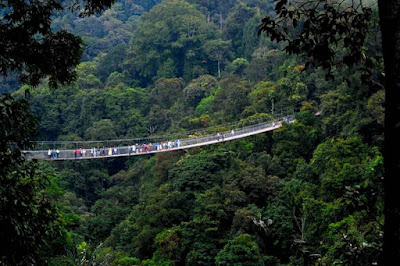The first
large-scale Asian–African or Afro–Asian Conference—also known as
the Bandung Conference—was a meeting of Asian and African states, most of
which were newly independent, which took place on April 18–24, 1955 in Bandung, Indonesia.
The Asian-African
Conference gained a big success both in formulating common concerns and in
preparing operational guidance for cooperation among Asian African Nation as
well as in creating world order and world peace. The conference has had a
result Dasasila Bandung, which became the guideline for the colonized countries
in fighting for their independence. It also became the fundamental principles
in promoting world peace and international cooperation. The success of the
conference was not only for the time being but also for the time after so that
the soul and spirit of the Asian-African Conference becomes one of the most
important factor that deciding world history.
All is a huge
prestige that gained by the Asian African Nations. The spirit of Bandung had
succeeded in widening the work volume among Asian African Nations. As a
consequence, their influence and their role in international cooperation are
increased and more respected.
In order to maintain
those mentions above, it is important if the Asian-African Conference with its
event is maintained eternally in a museum where the conference was held, Gedung
Merdeka, Bandung, a city that is considered as a capital city and a source of
inspiration for the Asian-African Nations.
Inspired by desires
to eternalize the Asian-African Conference, the idea of establishing a Museum
of the Asian-African Conference in Gedung Merdeka was born by Prof. Dr. Mochtar
Kusumaatmadja, S.H., LL.M.. The idea was delivered in the meeting of the
Committee for the Commemoration of the 25th Anniversary of the Asian-African
Conference (1980), which was attended by Directorate General of Culture, Prof.
Dr. Haryati Soebadio as a representative for the Department of Culture and
Education. Fortunately, the idea was fully supported including President of the
Republic of Indonesia, Soeharto.
The idea of
establishing the Museum of the Asian-African Conference had been materialized
by Joop Ave, the Executive Chairman of the Committee of the 25th Anniversary of
the Asian-African Conference and Director General of Protocol and Consular in
the Department of Foreign Affairs in cooperation with Department of
Information, Department of Education and Culture, the Provincial Government of
West Java, and Padjadjaran University. The technical planning and its execution
was carried out by PT Decenta, Bandung.
The Museum of the
Asian-African Conference was inaugurated by President of the Republic of
Indonesia, Soeharto on 24th April 1980 as the culmination of the 25th
Anniversary of the Asian-African Conference.
The Museum of the
Asian-African Conference has a permanent exhibition room, which exhibits
collections of three-dimensional objects and documentary photos of the
preparatory Tugu Meeting, the Colombo Conference, the Bogor Meeting and the
Asian-African Conference 1955.
The exhibition room
also provides:
- the historical
events that become the background of the Asian- African Conference;
- the effect of the
Asian-African Conference to the world;
- Gedung Merdeka
from time to time;
- Profile of
participating countries of the Asian-African Conference performed in
multimedia.
In the Museum has also
a library provides books on the history, social, politics, and cultures of the
Asian African Countries and others; documents of the Asian-African Conference
and its preparatory conferences; magazines and newspapers donated by other
institutions or gained through purchase.






























